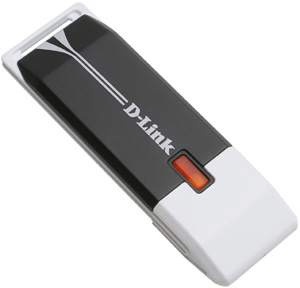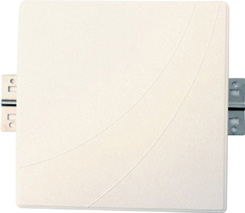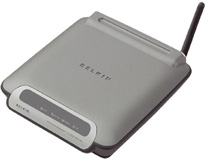Chapter 16. Speeding Up Your Home Network
If you have more than one computer in your house or office, chances are they’re connected to each other over a local area network or LAN. A network can be either wired (via Ethernet cables) or wireless (using Wi-Fi technology), and is also used to let all your connected computers share a single Internet connection.
Because you use a network connection both to access the Internet and share data with other computers, any network sluggishness can affect your computing experience. If the network is slow, your Internet connection and file transfers are slow. It’s not your PC; it can only work as fast as the network lets it.
With that in mind, let’s look at how to speed up a typical home network. There are lots of things to look at, as you’ll soon discover.
Wireless networks are more prone to sluggishness than wired ones. That’s because sending the network signal through the air, using radio frequency (RF) signals, is not as bulletproof as sending that same signal through a shielded cable. As you know from listening to AM and FM radio and watching television via rabbit ear antennae, lots of things can interfere with over-the-air signals.
Note
If you already have a wireless network set up, I’m going to assume that you’re familiar with all the components of the network: the router, which is the hub for all network connections, and the wireless adapters, one of which is connected to each computer on the network and enables the reception of wireless network signals.
A poor wireless connection most often manifests itself as a low signal, which provides slower data access than a faster signal. With that in mind, here are some things to look for when your wireless network starts slowing down.
First things first: How strong is the wireless signal received by your computer? It’s relatively easy to determine.
To view the strength of your current wireless signal, hover your cursor over the wireless connection icon in the Windows system tray. This displays a pop-up information window that describes the current network’s signal strength. If the signal strength is less than 100%, your network connection is slower than it could be.
If your signal strength is low or your network connection seems sluggish, check to see how far away your computer is from the wireless router. It’s a simple fact: The farther away your computer is from the router, the weaker the signal—and the slower the connection.
A simple solution, if you can do it, is to move your computer closer to the router. If that sounds like it’s too easy, think again. The closer a remote computer is to the network router, the faster the wireless connection. If you don’t believe me, position a notebook computer right next to the router and measure the wireless signal strength, then move it to the other side of the house and measure again. The wireless signal strength drops with distance, and less signal strength equals slower data transfer rates.
So if the wireless connection on your computer is feeling sluggish, try moving the computer a few feet closer to the router. Alternatively, you can move the router closer to the computer—whichever is easiest for you. But don’t complain about slow network speeds if your computer is positioned at the extreme end of your router’s range; move it closer to speed it up!
You can also increase signal strength—and speed up your connection—by not hiding your wireless adapter or router. If you use a USB wireless adapter, for example, it may be stuck down on the floor behind your PC, which is a perfect way to interfere with the Wi-Fi signal. Move the adapter out from behind the PC and raise it off the floor; you’ll notice a marked increase in signal strength. The same thing goes with your wireless router; if it’s hidden behind other equipment, you’ll reduce its transmission range.
Along the same lines, you might be able to improve performance by moving or redirecting the antenna on your router or wireless adapter. Radio signals are directional; swiveling the antenna one direction or another can make a world of difference.
You might not realize it, but placing a wireless router or adapter too close to other electronic equipment can reduce the effectiveness of the Wi-Fi signal. The other wireless signals effectively scramble the wireless network signal, reducing the resultant signal strength—and connection speed.
For example, I once ran into problems when I placed my wireless router between a cordless phone and my computer monitor—both devices that generate their own electronic signals or fields. Just moving the router to the other side of these devices dramatically increased its effective signal strength.
This last point reminds us that interference from other devices can affect the Wi-Fi signal. It’s never a good idea to put your wireless router or adapter in close proximity to other cordless devices that use the 2.4GHz frequency band. In some instances, you may need to disconnect or turn off these other devices to get a clean Wi-Fi signal.
Tip
If network interference is being caused by an older cordless telephone, consider upgrading to a newer 5.8GHz phone that doesn’t operate in the same band as your Wi-Fi equipment.
This type of interference can sometimes be minimized by changing the wireless broadcast channel used by your router and adapter. Every router has the option of transmitting on any one of multiple channels, which use different portions of the available 2.4GHz band. If multiple devices (or multiple networks—such as yours and a neighbor’s) use the same channel, interference can result.
To change the channel that your equipment uses, run your wireless router’s configuration utility. Consult your router’s manual for specific instructions.
If your wireless network is consistently slow, consider upgrading to a faster router. Fortunately, the Wi-Fi standard is continually evolving.
Today’s wireless networks use a type of RF transmission called Wi-Fi (short for wireless fidelity). This is the consumer-friendly name for the technology defined by the IEEE 802.11 wireless networking standard.
But here’s the thing. There isn’t a single Wi-Fi protocol. Instead, there are multiple 802.11 protocols, each designated by a single-letter suffix. Different versions of Wi-Fi offer different levels of performance. Which of these Wi-Fi standards you choose for your wireless network depends on your needs—and the equipment currently available for purchase.
Note
The Wi-Fi standard was developed by an industry group called the Wi-Fi Alliance. Learn more at the Wi-Fi Alliance website (www.wi-fi.org).
Table 16.1 summarizes the specifications of the most popular 802.11 protocols for consumer use. Remember, the faster the data transfer rate, the speedier your network connection will be.
What does all this alphabet soup mean? Here’s the simple version. Older wireless equipment, sold from approximately 1999 to 2003, used the 802.11b protocol, which transfers data at 11Mbps. Equipment sold from 2003 to present use the 802.11g protocol, which transfers data close to five times as fast, at 54Mbps. Newer equipment is now available that use a draft version of the upcoming 802.11n protocol, which speeds things up by a factor of 10, transferring data at a potential 540Mbps. The newer the equipment, the faster the network.
Note
The stated data transfer rates for each Wi-Fi protocol are the theoretical maximum. Actual transfer rates typically average half the maximum. This is because wireless devices don’t operate in a vacuum; walls, floors, and other obstructions and devices (as well as distance) negatively affect signal strength, and thus the transfer rate.
Fortunately, each newer Wi-Fi protocol is backward compatible with earlier versions. So if you buy a draft 802.11n router, you can still use it with older 802.11g adapters. This is another reason to buy the latest technology available—which, today, is the draft version of 802.11n, sometimes referred to as Pre-N.
Note
Some manufacturers today sell what they call Extreme G equipment. This equipment upgrades the standard 802.11g firmware to achieve data transfer rates of 108Mbps—twice the normal 802.11g rate. Note, however, that Extreme G equipment from one manufacturer may be incompatible with similar equipment from a different manufacturer, at least at the higher speeds.
A quick note is necessary about Wi-Fi transmission range, however. Radio signals don’t suddenly stop when they get out of range; they weaken as you get farther away from the transmitter. So an 802.11g network, for example, won’t go completely dead when you get 100 feet distant. Instead, the data transfer rate decreases as the signal decreases. Get 100 or 110 feet away from an 802.11g transmitter, and you’re likely to find your transfer rate decreasing from 54Mbps to something approaching 11Mbps.
With that in mind, what type of real-world performance can you expect from an 802.11n network? Actual data transfer rates should be at least 200Mbps and possibly up to 540Mbps. That’s because 802.11n routers use “smart” multiple in, multiple out (MIMO) antennas that provide not only faster data transfer rates but also an extended transmission range. Whereas current 802.11b and 802.11g equipment have a usable range of about 100 feet between transmitter and receiver, 802.11n promises a range of at least 160 feet, and possibly double that, with less interference from other wireless household devices.
In other words, 802.11n is the way to go when purchasing new equipment.
The key to creating a faster and farther-reaching network, therefore, is to upgrade your wireless router. If you have an older 802.11b or 802.11g router, upgrading to a 802.11n model, like the one in Figure 16.1, will increase both your network speed and range.
Naturally, to gain full advantage of a faster router, you’ll also need to upgrade all your wireless adapters to the matching standard. Move from an 802.11g to an 802.11n router, and you’ll need 802.11n adapters to recognize the full speed improvement.
Tip
Router manufacturers often make interim improvements to their routers that sometimes increase performance. These improvements are typically implemented via updates to the router’s firmware—the built-in software that runs the router. To get the latest firmware updates for your router, visit the website for your router manufacturer.
That said, sometimes upgrading your router will provide a signal strength improvement for existing adapters. As an example, I recently upgraded my network from an 802.11g router to an 802.11n model. I didn’t upgrade all of my wireless adapters, but found that my most distant adapter now picked up a stronger signal from the new router. And, of course, a stronger signal is always desirable. The stronger the signal, the more stable (fewer dropouts or dropped connections) and faster the connection—up to maximum protocol speeds, of course.
Upgrading your wireless modem is a deceptively simple task. After you purchase the new router, here are the basic steps you need to follow:
1. With your old router still connected, run the configuration software for the new router. (You need an existing connection to register and activate the installation software, as well as to download any necessary updates for the new router.)
2. When prompted, disconnect and remove the old router.
3. Place the new router in position and connect to it all existing cables.
4. Finish running the installation routine for the new router.
Naturally, if you change any network settings (such as the router’s SSID or encryption passphrase), you’ll need to reconfigure your other network devices for this new router. This might mean setting up a new network on each of your network computers, or simply changing configuration settings on all your wireless adapters.
When you upgrade your wireless router to a newer Wi-Fi protocol, you should also upgrade all your wireless adapters. So if you purchase an 802.11n router, you need to upgrade to 802.11n adapters for all your computers to gain full advantage of the new router’s faster speed.
Upgrading to a new wireless adapter, like the one shown in Figure 16.2, is relatively easy. After you purchase a new adapter, follow these general steps:
1. Disconnect your current wireless adapter.
2. Uninstall any software used for the current adapter.
3. Run the setup routine for the new adapter.
4. When prompted, connect the new adapter to a USB port on your PC.
5. Configure the new adapter as necessary for your network.
Naturally, you’ll use your existing SSID, passphrase, and workgroup name to configure the new adapter. When installed, the adapter should use all the other existing network settings on the attached computer; all your network places, shared folders, and the like should remain the same.
You don’t necessarily have to upgrade all your network equipment to get a faster network. Better performance can often be had by adding a piece of equipment or two to your network configuration.
Some wireless networks can be speeded up by replacing the router’s built-in antenna with an external antenna. This type of antenna, bigger than the one built into the router, can provide greater range than the original—and greater range equals faster data transfer rates.
Note
Most external Wi-Fi antennas are designed to be used with specific routers. Make sure the antenna you choose is compatible with your existing wireless router.
Most network equipment manufacturers sell external antennas for their routers. Some antennas, such as the one shown in Figure 16.3, are omnidirectional, and thus can service a large surrounding area.
Others, like the one shown in Figure 16.4, are more directional antenna. (A directional antenna is best when your router is located on an outside wall and you want to focus your RF signals in a single direction—inward rather than beaming outside into your neighborhood.)
Another way to extend the range of your wireless network is with a wireless extender or repeater, like the one shown in Figure 16.5. An extender is a passive device that receives and then retransmits Wi-Fi signals, no network configuration necessary.
Installing a wireless extender is simplicity itself. In most cases, all you have to do is set it in place and plug it into a power outlet; no network setup is required. Position the extender at the farthest range of your current network, or halfway between your router and your farthermost computer. The device will extend your network from that point.
Tip
If you have a notebook PC that includes both a Wi-Fi adapter and an Ethernet connection, you can use both a wireless and a wired connection, depending on what you need at the time. When you’re at a distance from your router, use the more convenient wireless connection. But when you’re physically close to your router, just connect an Ethernet cable between the router and your notebook. When an Ethernet connection is made, it automatically overrides the wireless connection for faster speed. (On some notebooks, you might also need to turn off a wireless adapter switch.)
Even the fastest wireless network isn’t as fast as a wired one. A new Gigabit Ethernet network transfers data at 1Gbps—one gigabit per second. That’s equal to 1000Mbps, twice as fast as a new 802.11n wireless network or 20 times as fast as an older 802.11g network. You’ll definitely notice that kind of speed increase.
Caution
If your PC doesn’t have an Ethernet port built in, you’ll need to install an internal network interface card (NIC) or external Ethernet adapter (typically to a USB port on the device).
Tip
When shopping for a new router, look for one with Gigabit Ethernet capability. Some lower-priced routers come with the slower 10/100 Ethernet, which is capable of only (!) 100Mbps data transfer rates.
For that reason, if you want really speedy network connections, you need to change from a wireless to a wired connection for the remote PC. To do this, you need a wireless router that also functions as a wired router. Fortunately, most current wireless routers also offer Ethernet functionality. Your remote PC must also have Ethernet functionality. Again, most desktop and notebook PCs sold in the past few years include Ethernet ports.
To switch a PC from wireless to Ethernet connection, follow these general steps:
1. Disconnect or deactivate the wireless adapter on the PC you want to switch.
2. Uninstall the software for the wireless adapter.
3. Connect one end of an Ethernet cable to the Ethernet port on the PC.
4. Connect the other end of the Ethernet cable to a spare port on your network router.
Many computers and devices automatically detect the new network connection and perform any necessary configuration automatically. Other devices may need to be configured for the new Ethernet connection. Follow the instructions for your particular device.
If you have a Windows XP computer, have you ever noticed that when you use the network to share data with other computers, it takes a long time for the files on that other computer to appear on your computer’s screen? At times, it almost seems as if your computer is slowing down to a complete freeze before the folder window becomes active. Why is that?
The cause is due to the fact that before it displays shared folders, Windows XP looks for scheduled tasks on the remote computer. This can take some time on some computers and significantly slow down your network access, as your computer waits for a response from the remote computer.
And here’s the thing: Unless you’re an administrator on a big network, information about these scheduled tasks is totally useless. Your computer is waiting for something that is of no value to you.
Fortunately, you can disable this feature by editing the Windows registry using the Registry Editor utility. Here’s how to do it:
1. Open the Registry Editor.
2. Navigate to the HKEY_LOCAL_MACHINESoftwareMicrosoftWindowsCurrentVersionExplorerRemoteComputerNameSpace key and expand the folder.
3. Right click the folder labeled {D6277990-4C6A-11CF-8D87-00AA0060F5BF} and select Delete from the pop-up menu.
Note
This speedup is necessary only on computers running Windows XP. Windows Vista does not check for remote scheduled tasks the same way Windows XP does, and thus enables faster network browsing by default.
After you have deleted this folder, close the Registry Editor and restart your PC for the changes to take effect.
Whether you’re sharing files with another computer or accessing a shared Internet connection, the speed of your network connection affects what you’re doing. Here’s the bottom line:
![]() Wireless network speed is dependent on signal strength. Moving a remote computer closer to the network’s wireless router will increase the signal strength and speed up the connection.
Wireless network speed is dependent on signal strength. Moving a remote computer closer to the network’s wireless router will increase the signal strength and speed up the connection.
![]() You can vastly increase wireless network speed by upgrading to new 802.11n equipment.
You can vastly increase wireless network speed by upgrading to new 802.11n equipment.
![]() Other ways to boost performance of an existing wireless network include adding an external antenna to your router and using a wireless extender.
Other ways to boost performance of an existing wireless network include adding an external antenna to your router and using a wireless extender.
![]() For even faster network performance, switch from a wireless to a Gigabit Ethernet wired connection.
For even faster network performance, switch from a wireless to a Gigabit Ethernet wired connection.
![]() If you’re running Windows XP, you can speed up access to network folders by tweaking the Windows Registry.
If you’re running Windows XP, you can speed up access to network folders by tweaking the Windows Registry.






